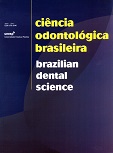Adenoma pleomorfo e carcinoma ex-adenoma pleomorfo: uma revisão clínica e morfológica
DOI:
https://doi.org/10.14295/bds.2006.v9i4.451Abstract
O adenoma pleomorfo (AP) é o tumor de glândula salivar mais comum e caracteriza-se pela diversidade morfológica. Sua transformação maligna origina o carcinoma ex-adenoma pleomorfo (CAP). O objetivo deste trabalho foi traçar o perfi l clínico e morfológico de todos os APs e CAPs dos arquivos do Serviço de Anatomia Patológica da Faculdade de Odontologia de Bauru - USP compreendendo o período de 1963 até 2003 e estabelecer correlações entre os aspectos encontrados e os já descritos na literatura. A metodologia adotada foi a revisão de 58 APs e três CAPs de glândulas salivares através de análise de fi chas clínicas e cortes microscópicos corados em HE dos arquivos do departamento. Constatamos que o gênero mais afetado pelo AP e CAP foi o feminino, com faixa etária da 3ª a 5ª e 6ª a 7ª décadas de vida, respectivamente. A localização mais freqüente foi no palato para ambos, e as características microscópicas representativas foram o estroma fibro-hialino, as estruturas epiteliais em ilhotas, cordões e ductos para os adenomas e nos carcinomas a metaplasia escamosa, e as células claras em estruturas ductais e acinares. A literatura permitiu uma discussão ampla com relação aos diversos aspectos abordados neste estudo de revisão clínica e morfológica dos APs e CAPs. É importante avaliar cada minúcia destas lesões para o estabelecimento do diagnóstico preciso e seguro de AP ou CAP.
Downloads
Downloads
Published
How to Cite
Issue
Section
License
Brazilian Dental Science uses the Creative Commons (CC-BY 4.0) license, thus preserving the integrity of articles in an open access environment. The journal allows the author to retain publishing rights without restrictions.
=================




























